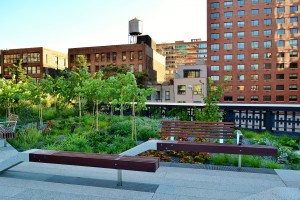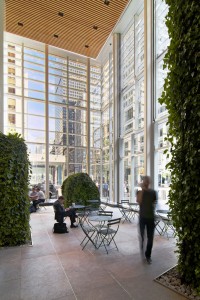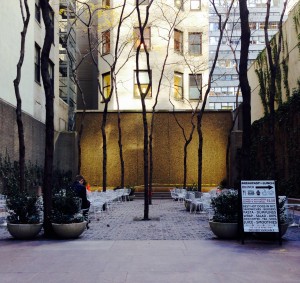December 28, 2015
by Lisa Bonanate

Have you ever wondered why the sound of waves, a walk in the woods or a secluded refuge are universally appealing? One school of thought says that man has an innate need to connect with the natural world. Biophilia – meaning “love of life” – is the term used to describe this instinctive response to nature. It originated with psychologist Erich Fromm, but became popular through the writings of biologist Edward O. Wilson, who proposed that our attraction to nature is actually rooted in our biology. But beyond the sensory appeal, biophilic design in the built environment plays an important role in physical and psychological well-being – and that can ultimately translate into economic benefits.
At
Terrapin Bright Green, a sustainability consulting and strategic planning firm, incorporating nature into design principles is a primary objective. The firm works with architects and engineers to design biophilic interventions that reconnect people with nature. According to Jonce Walker, an urban planner and Senior Project Manager at Terrapin, biophilia is particularly important as we urbanize. “We’ve been focused on energy and building performance but have tended to ignore the human experience,” he said. “Buildings should not only perform well but should be places we want to be, not sterile boxes.” He added, “We don’t want to ‘design out’ nature.”
What is Biophilic Design?
In
14 Patterns of Biophilic Design, Terrapin identifies fourteen design principles that have well-documented research linking them to reduced stress, better concentration and improved health. These principles fall into three categories.
Nature in the Space refers to seven design patterns that create a direct connection with nature. Examples include indoor gardens, ivy-covered walls, fountains, waterfalls and natural lighting. Design patterns that evoke an indirect connection with nature are called Natural Analogues. These include artwork, the use of natural materials like wood or granite, and mimicry of natural shapes like shells or leaves. Nature of the Space incorporates spatial configurations found in nature. These four design principles draw on our fascination with mystery and the unknown. Examples include spaces that create a sense of refuge, unimpeded views over a distance or conversely, partially obscured views that create a sense of mystery.

©Cook+Fox Architects/ CTBUH
A good example of biophilic design in a building environment is The Bank of America Tower, designed by
CookFox Architects. “The first thing you touch when you enter the building is a wooden door handle, rather than metal,” Walker said. The lobby features floor-to-ceiling Jerusalem stone embedded with fossils and the ceiling is covered in bamboo. A public atrium is filled with ivy and natural light. These are intentional design elements that bring nature into the space.
Biophilic Urban Acupuncture
Biophilia is equally important in outdoor spaces, especially in densely populated cities.
Biophilic urban acupuncture describes small-scale interventions throughout a city that reconnect people with nature. Parks are obvious examples, as are urban gardens and even subway art depicting nature.

Along New York’s popular
High Line, native plantings create a variety of habitats, allowing visitors to experience grasslands, wildflowers, water features and protected spaces. Paley Park, located off Fifth Avenue, is another example of urban acupuncture. The small “pocket park” has a waterfall that drowns out noise from the street and, combined with ivy-covered walls, creates a sense of refuge from the city. The park was completed in 1967, before the principles of biophilic design were intentionally in use, supporting the idea that good design has intuitively incorporated biophilia all along.
Beyond the aesthetic appeal of biophilic design, a number of research studies provide evidence for its positive impact on health and performance, including reduced stress hormones, lower blood pressure and heart rate, reduced anger and depression, and improved concentration.
Health and Cost Benefits
In
The Economics of Biophilia, Terrapin Bright Green compiled a number of research findings creating a compelling business case for bringing biophilia into our built environments. For example, a 1984 study showed that patients with a view of nature from their hospital rooms needed less pain medication and had faster recovery rates, resulting in an 8.5% shorter hospital stay. (1) Studies in the 1990’s linked views of nature to improved worker productivity and a 10% reduction in absenteeism. (2) Employees with a view to the outdoors and exposure to natural daylight took an average of 57 hours of sick leave annually versus 68 hours per year taken by those with no view. (3) Several other studies showed that good daylighting in schools increased attendance by 3.2 – 3.8 days per year, and improved test scores from 5 and 18%. (4)
Health benefits can translate into financial benefits. “Integrating quality daylighting schemes into an office space can save over $2,000 per employee per year in office costs, whereas over $93 million could be saved annually in healthcare costs as a result of providing patients with views to nature.” (5)
These demonstrated benefits to health and the bottom line will ultimately be the motivators that drive intentional use of biophilic design principles. As an added benefit, biophilia fosters appreciation of our natural surroundings. “When we appreciate spaces, we take care of spaces,” Jonce Walker commented.
That’s an important mindset that could foster better protection of our fragile environment.
(1) Ulrich, R.S. “View through a window may influence recovery from surgery” Science, Vol. 224, 1984
(2) Terrapin Bright Green,
The Economics of Biophilia, New York, NY, 2012, p. 30.
(3) Ibid, p. 12.
(4) Ibid, p. 3.
(5) Ibid, p. 3.
 Have you ever wondered why the sound of waves, a walk in the woods or a secluded refuge are universally appealing? One school of thought says that man has an innate need to connect with the natural world. Biophilia – meaning “love of life” – is the term used to describe this instinctive response to nature. It originated with psychologist Erich Fromm, but became popular through the writings of biologist Edward O. Wilson, who proposed that our attraction to nature is actually rooted in our biology. But beyond the sensory appeal, biophilic design in the built environment plays an important role in physical and psychological well-being – and that can ultimately translate into economic benefits.
At Terrapin Bright Green, a sustainability consulting and strategic planning firm, incorporating nature into design principles is a primary objective. The firm works with architects and engineers to design biophilic interventions that reconnect people with nature. According to Jonce Walker, an urban planner and Senior Project Manager at Terrapin, biophilia is particularly important as we urbanize. “We’ve been focused on energy and building performance but have tended to ignore the human experience,” he said. “Buildings should not only perform well but should be places we want to be, not sterile boxes.” He added, “We don’t want to ‘design out’ nature.”
What is Biophilic Design?
In 14 Patterns of Biophilic Design, Terrapin identifies fourteen design principles that have well-documented research linking them to reduced stress, better concentration and improved health. These principles fall into three categories.
Nature in the Space refers to seven design patterns that create a direct connection with nature. Examples include indoor gardens, ivy-covered walls, fountains, waterfalls and natural lighting. Design patterns that evoke an indirect connection with nature are called Natural Analogues. These include artwork, the use of natural materials like wood or granite, and mimicry of natural shapes like shells or leaves. Nature of the Space incorporates spatial configurations found in nature. These four design principles draw on our fascination with mystery and the unknown. Examples include spaces that create a sense of refuge, unimpeded views over a distance or conversely, partially obscured views that create a sense of mystery.
A good example of biophilic design in a building environment is The Bank of America Tower, designed by CookFox Architects. “The first thing you touch when you enter the building is a wooden door handle, rather than metal,” Walker said. The lobby features floor-to-ceiling Jerusalem stone embedded with fossils and the ceiling is covered in bamboo. A public atrium is filled with ivy and natural light. These are intentional design elements that bring nature into the space.
Biophilic Urban Acupuncture
Biophilia is equally important in outdoor spaces, especially in densely populated cities. Biophilic urban acupuncture describes small-scale interventions throughout a city that reconnect people with nature. Parks are obvious examples, as are urban gardens and even subway art depicting nature.
Have you ever wondered why the sound of waves, a walk in the woods or a secluded refuge are universally appealing? One school of thought says that man has an innate need to connect with the natural world. Biophilia – meaning “love of life” – is the term used to describe this instinctive response to nature. It originated with psychologist Erich Fromm, but became popular through the writings of biologist Edward O. Wilson, who proposed that our attraction to nature is actually rooted in our biology. But beyond the sensory appeal, biophilic design in the built environment plays an important role in physical and psychological well-being – and that can ultimately translate into economic benefits.
At Terrapin Bright Green, a sustainability consulting and strategic planning firm, incorporating nature into design principles is a primary objective. The firm works with architects and engineers to design biophilic interventions that reconnect people with nature. According to Jonce Walker, an urban planner and Senior Project Manager at Terrapin, biophilia is particularly important as we urbanize. “We’ve been focused on energy and building performance but have tended to ignore the human experience,” he said. “Buildings should not only perform well but should be places we want to be, not sterile boxes.” He added, “We don’t want to ‘design out’ nature.”
What is Biophilic Design?
In 14 Patterns of Biophilic Design, Terrapin identifies fourteen design principles that have well-documented research linking them to reduced stress, better concentration and improved health. These principles fall into three categories.
Nature in the Space refers to seven design patterns that create a direct connection with nature. Examples include indoor gardens, ivy-covered walls, fountains, waterfalls and natural lighting. Design patterns that evoke an indirect connection with nature are called Natural Analogues. These include artwork, the use of natural materials like wood or granite, and mimicry of natural shapes like shells or leaves. Nature of the Space incorporates spatial configurations found in nature. These four design principles draw on our fascination with mystery and the unknown. Examples include spaces that create a sense of refuge, unimpeded views over a distance or conversely, partially obscured views that create a sense of mystery.
A good example of biophilic design in a building environment is The Bank of America Tower, designed by CookFox Architects. “The first thing you touch when you enter the building is a wooden door handle, rather than metal,” Walker said. The lobby features floor-to-ceiling Jerusalem stone embedded with fossils and the ceiling is covered in bamboo. A public atrium is filled with ivy and natural light. These are intentional design elements that bring nature into the space.
Biophilic Urban Acupuncture
Biophilia is equally important in outdoor spaces, especially in densely populated cities. Biophilic urban acupuncture describes small-scale interventions throughout a city that reconnect people with nature. Parks are obvious examples, as are urban gardens and even subway art depicting nature.
 Along New York’s popular High Line, native plantings create a variety of habitats, allowing visitors to experience grasslands, wildflowers, water features and protected spaces. Paley Park, located off Fifth Avenue, is another example of urban acupuncture. The small “pocket park” has a waterfall that drowns out noise from the street and, combined with ivy-covered walls, creates a sense of refuge from the city. The park was completed in 1967, before the principles of biophilic design were intentionally in use, supporting the idea that good design has intuitively incorporated biophilia all along.
Beyond the aesthetic appeal of biophilic design, a number of research studies provide evidence for its positive impact on health and performance, including reduced stress hormones, lower blood pressure and heart rate, reduced anger and depression, and improved concentration.
Health and Cost Benefits
In The Economics of Biophilia, Terrapin Bright Green compiled a number of research findings creating a compelling business case for bringing biophilia into our built environments. For example, a 1984 study showed that patients with a view of nature from their hospital rooms needed less pain medication and had faster recovery rates, resulting in an 8.5% shorter hospital stay. (1) Studies in the 1990’s linked views of nature to improved worker productivity and a 10% reduction in absenteeism. (2) Employees with a view to the outdoors and exposure to natural daylight took an average of 57 hours of sick leave annually versus 68 hours per year taken by those with no view. (3) Several other studies showed that good daylighting in schools increased attendance by 3.2 – 3.8 days per year, and improved test scores from 5 and 18%. (4)
Health benefits can translate into financial benefits. “Integrating quality daylighting schemes into an office space can save over $2,000 per employee per year in office costs, whereas over $93 million could be saved annually in healthcare costs as a result of providing patients with views to nature.” (5)
These demonstrated benefits to health and the bottom line will ultimately be the motivators that drive intentional use of biophilic design principles. As an added benefit, biophilia fosters appreciation of our natural surroundings. “When we appreciate spaces, we take care of spaces,” Jonce Walker commented.
That’s an important mindset that could foster better protection of our fragile environment.
(1) Ulrich, R.S. “View through a window may influence recovery from surgery” Science, Vol. 224, 1984
(2) Terrapin Bright Green, The Economics of Biophilia, New York, NY, 2012, p. 30.
(3) Ibid, p. 12.
(4) Ibid, p. 3.
(5) Ibid, p. 3.
Along New York’s popular High Line, native plantings create a variety of habitats, allowing visitors to experience grasslands, wildflowers, water features and protected spaces. Paley Park, located off Fifth Avenue, is another example of urban acupuncture. The small “pocket park” has a waterfall that drowns out noise from the street and, combined with ivy-covered walls, creates a sense of refuge from the city. The park was completed in 1967, before the principles of biophilic design were intentionally in use, supporting the idea that good design has intuitively incorporated biophilia all along.
Beyond the aesthetic appeal of biophilic design, a number of research studies provide evidence for its positive impact on health and performance, including reduced stress hormones, lower blood pressure and heart rate, reduced anger and depression, and improved concentration.
Health and Cost Benefits
In The Economics of Biophilia, Terrapin Bright Green compiled a number of research findings creating a compelling business case for bringing biophilia into our built environments. For example, a 1984 study showed that patients with a view of nature from their hospital rooms needed less pain medication and had faster recovery rates, resulting in an 8.5% shorter hospital stay. (1) Studies in the 1990’s linked views of nature to improved worker productivity and a 10% reduction in absenteeism. (2) Employees with a view to the outdoors and exposure to natural daylight took an average of 57 hours of sick leave annually versus 68 hours per year taken by those with no view. (3) Several other studies showed that good daylighting in schools increased attendance by 3.2 – 3.8 days per year, and improved test scores from 5 and 18%. (4)
Health benefits can translate into financial benefits. “Integrating quality daylighting schemes into an office space can save over $2,000 per employee per year in office costs, whereas over $93 million could be saved annually in healthcare costs as a result of providing patients with views to nature.” (5)
These demonstrated benefits to health and the bottom line will ultimately be the motivators that drive intentional use of biophilic design principles. As an added benefit, biophilia fosters appreciation of our natural surroundings. “When we appreciate spaces, we take care of spaces,” Jonce Walker commented.
That’s an important mindset that could foster better protection of our fragile environment.
(1) Ulrich, R.S. “View through a window may influence recovery from surgery” Science, Vol. 224, 1984
(2) Terrapin Bright Green, The Economics of Biophilia, New York, NY, 2012, p. 30.
(3) Ibid, p. 12.
(4) Ibid, p. 3.
(5) Ibid, p. 3.

